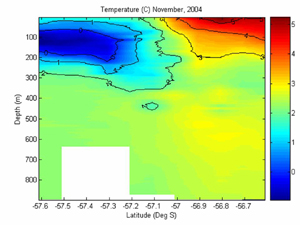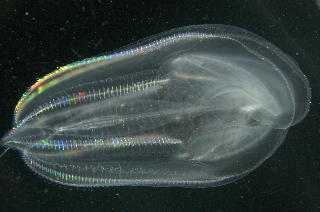| • Home |
| • Questions |
| • Participants |
| • Background Information |
Our weather window has held out so far. Seas are about 4 feet, and the wind is in the low 20’s. Captain Mike (“The Buck Stops Here”) Terminel reports he was watching a front coming our way that would probably have kicked us around some (“oh yeah, we’ve had 40 foot seas with steady 50 mph winds for 4 days!”).

| 1 | 2 | 3 | 4 | 5 | 6 | |
| 7 | 8 | 9 | 10 | 11 | 12 | 13 |
| 14 | 15 | 16 | 17 | 18 | 19 | 20 |
| 21 | 22 | 23 | 24 | 25 | 26 | 27 |
| 28 | 29 | 30 |
| 1 | 2 | 3 | 4 | |||
| 5 | 6 | 7 | 8 | 9 | 10 | 11 |
| 12 | 13 | 14 | 15 | 16 | 17 | 18 |
| 19 | 20 | 21 | 22 | 23 | 24 | 25 |
| 26 | 27 | 28 | 29 | 30 | 31 |
Good news is, it turned south instead of staying east, and missed us. Thank you, King Neptune. We have crossed the Burwood Bank and water depth has gone from a manageable (for benthic tows) 101 meters on 26 Nov., to over 4200 meters today!
Plankton tows today are yielding photo- not zoo-, so we’re looking for almost clear critters in stuff that looks like guacamole. Actually, the Lab Czars have come up with a plan to run the green stuff through a sieve system that clears it out quite a bit - only thing is, we haven’t found any target critters in the last couple of tows. (Our greatest contribution this afternoon was pair of salps for the lab across the hall.) I rather enjoyed looking through the diatoms (what the green stuff is made of), because they sort of shimmer, and are of very uniform size, like little pieces of greenish-blue fiberglass. Sort of gets you in the Christmas spirit.In an alternate pattern to plankton tows, a measuring device called an XBT is being used to measure the temperature of the water through the water column. Sandy Williams, a WHOI scientist/engineer, explains how this works, and has provided a chart that shows what the instrument is telling us via a colorful array [See Image 1 XBT]:
“The expendable bathythermograph or XBT is a probe that looks like a small (about 3 inch by 16 inch) fireworks pipe used for taking the temperature of the ocean. It not only measures the temperature of the water at the surface but takes the temperature all the way down to 800 meters or more by falling through the water while spinning out a two-conductor wire and sending the signal from its thermistor back to the ship. The ship is still steaming at 10 knots so it too needs to spin out a wire to the place where the XBT fell into the water. So there are actually two coils of very fine wire in an XBT, one in the probe and the other in the launcher on the ship. Eventually one or the other spool is emptied and the wire breaks, ending the profile. In the illustration, three profiles, at 57.3, 57.4, and 57.5 degrees south failed at 630 meters because the ship was going fast and the launcher wire ran out first. A section of profiles is useful to know when the ship has crossed a front and can expect to find different animals in the water. In this illustration, a profile was made every tenth degree of latitude and a computer program contoured these measurements and colored them. This section is arranged as though you are looking from the Atlantic into the Pacific with Antarctica to the left. Warm water to the right is less dense and floats slightly higher than the colder water to the left of the front. This makes the water on the right try to run down hill to the south but the rotation of the earth in the southern hemisphere causes this southward flow to turn left and the warm water flows east relative to the cold water. From the section you can also see that the coldest water, less than 0 degrees Celsius, is not at the surface but at 120 meters depth. The minimum temperature is -0.98 degrees which is below the freezing point of fresh water but this is salt water with a freezing point of -1.8 degrees. It is dense because of its temperature and would be expected to sink except that it must be less salty than the water beneath it. This is late spring in Antarctica and some ice melt could have freshened the cold water slightly to produce this cold core of water south of the Antarctic Polar Front.” [See Image 1 - XBT]
Catch of the Day: A lobate (lobed) ctenophore [See Image 2 - Lobate Ctenophore] was captured by the dive group, on what will probably be the last dive for a couple of days. It is extraordinary in that it looks like a more common ctenophore, but has what look like football player's shoulder pads on one end. Scientist Larry Madin says that it has not been described officially for science before (written up in a journal and named), so it remains nameless as an individual species. Anyone care to suggest a name for this jelly? I thought “Bubba” would be fitting, but I think more serious people would like a more scientific, Latin-sounding name.
Speaking of pet names, Adriene has adopted a squid critter from one of the benthic tows, whom she proudly introduces as “Chile”. Technically, there are no pets allowed on ship, but it’s ok if they’re in a jar. …and Chile doesn’t eat much. (We’re having a hard time breaking the news to Adriene that Chile is not really moving or breathing much, either. Sometimes “denial” is a beautiful thing.)

Tomorrow we finish the Drake Passage and look forward to Elephant Island!
Dinner Menu (shipboard, 11/29): |
|
Gravy Gumbo, |